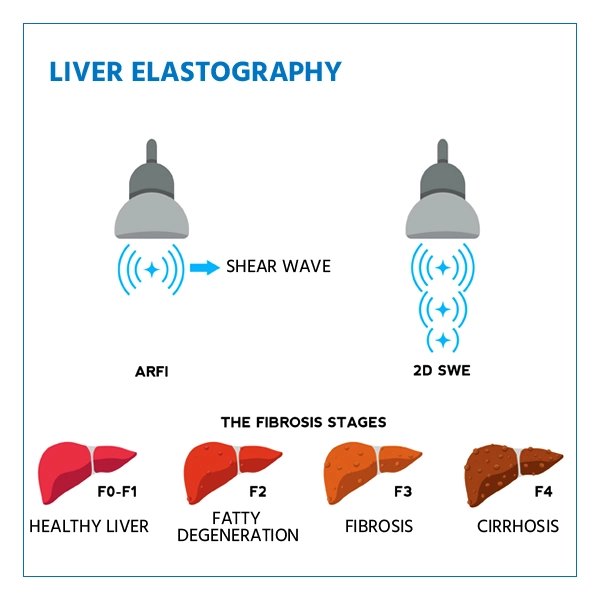Types of Liver Elastography
Ultrasound elastography, also known as Fibroscan, is a commonly used ultrasound technique. The test uses sound waves to measure the stiffness of liver tissue. Stiffness is a sign of fibrosis.
MRE (magnetic resonance elastography) is a test that combines ultrasound technology with nuclear magnetic resonance (MRI). MRI is a procedure that uses powerful magnets and radio waves to create images of internal organs and structures in the body.
Elastography testing may be used in place of a liver biopsy, a more invasive test that involves removing a piece of liver tissue for testing.
Other names: liver elastography, transient elastography, Fibroscan, MR elastography
Symptoms of Cirrhosis and Other Liver Diseases
The symptoms of cirrhosis and other liver diseases are similar and may include:
Liver Fibrosis can lead to serious liver problems! But early diagnosis & treatment can prevent fatal consequences. Consult ourGastroenterologist TODAY!
Liver Elastography Procedure
- The person will lie on an exam table with the right abdominal area exposed.
- An X-ray technician will spread the gel on the skin over the area.
- He or she will place a wand-like device, called a transducer, on the area of skin that covers the liver.
- The probe will emit a series of sound waves. The waves will travel to the liver and recover. The waves are so sharp no one can hear them.
- One may feel a gentle movement, but it shouldn't hurt.
- Sound waves are recorded, measured, and displayed on a monitor.
- The measurement shows the level of stiffness in the liver.
- The procedure only takes about five minutes.
MRE (magnetic resonance elastography) is done with the same type of machine and many of the same steps as a traditional MRI (magnetic resonance imaging) test. During an MRE procedure:
One will lie on an exam table.
- An X-ray technician will place a small pad on the abdomen. The pad will emit vibrations that will pass through the liver.
- The table will slide into an MRI scanner, which is a tunnel-shaped machine that contains the magnet. Earplugs or headphones may be provided before the test to help block out the noise from the scanner, which is very loud.
- Once inside the scanner, the pad will activate and send vibration measurements from the liver. The measurements will be recorded on a computer and converted into a visual map showing how stiff the liver is.
- The test lasts between 30 and 60 minutes.

What are the Possible Complications of Liver Elastography?
Most patients with chronic liver disease can be tested, but the test is not recommended or can be interpreted in patients with:
- Fluid in the abdomen
- Acute hepatitis
- Right heart failure
- Severe obesity
- Small rib spaces
- Inability to lie down

